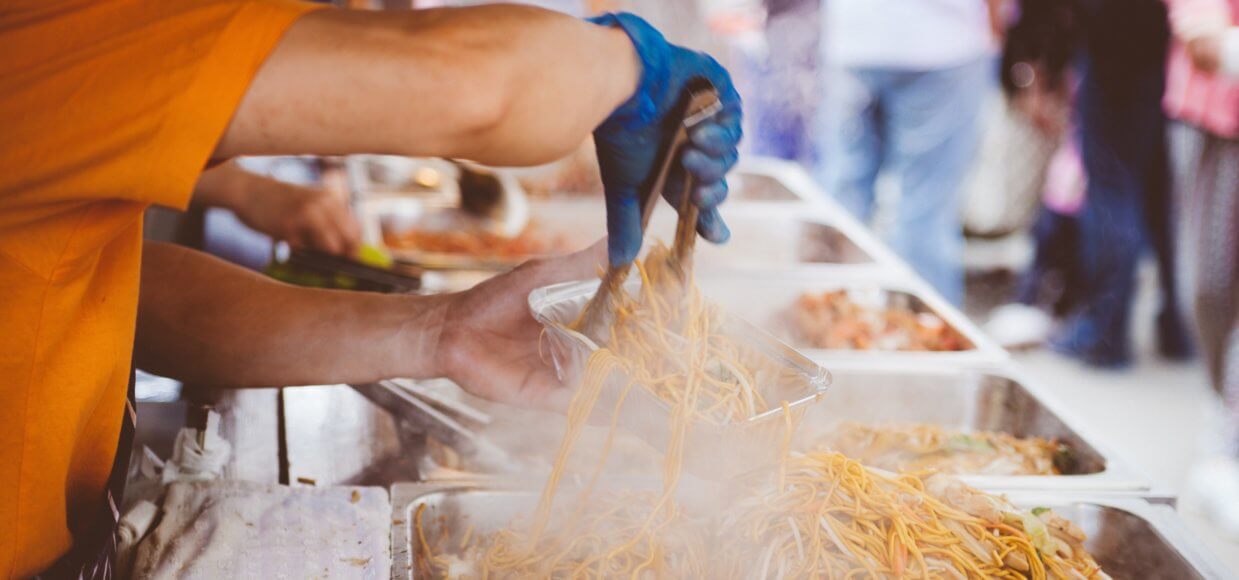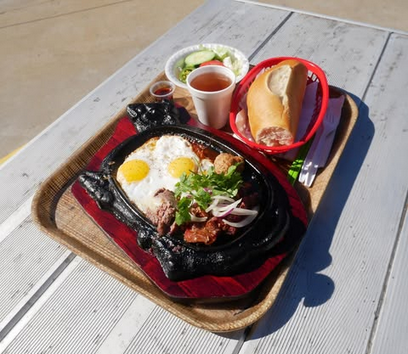
One recent Monday night, I stood in the Fort Mason Center parking lot with fork and pen in hand and watched as mobile food vendors auditioned to participate in the nature-healing return of Off The Grid’s flagship Friday night event, which begins on April 1, after an unexpected two-year hibernation. A young chef, cooking with his brother and her daughter, reminisced on how he and his sibling came to Fort Mason on Friday nights about five or six years ago and had fun checking out all the food trucks and tents. He expressed what an honor it would be if they were selected to participate in Off The Grid.
This was really moving to witness, and their food was exactly the kind of quality and creativity that I want to experience when I go to Off The Grid Fort Mason Center, where there’s always been great joy to be found in discovering new bites and making friends. It’s all coming back full circle now.
How It All Started
The return of the event reminds me of how Off The Grid founder Matt Cohen was so instrumental in getting Bay Area city officials to change laws to allow mobile food vendors, which was no small feat, and how he saw that people were craving community experiences as much as the food itself. He had noticed as much while living in Japan, and then observed the seeds here in San Francisco as an irreverent renegade scene began to crystallize in 2009, with people selling homemade food by foot, bike basket, bustaurant, folding table and ironing board.
“Street food is less a trend than the leading edge of a change in our relationship with food,” he wrote in late 2009. “Street food is about giving people adventure, immediacy, intimacy (with the people who cook that food) and a diversity of flavors that you can’t easily find in one restaurant.”
I spoke to Cohen a week before he launched the flagship Fort Mason Center event on June 25, 2010 in order to write a preview of the event for SF Weekly.
“It’s like if you take a bit of Japanese yatai [mobile food stall] and a bit of Latino bodega and shake,” is how he explained the intended vibe.
Among the vendors who sold in trucks or tents on that first night at Fort Mason Center were Julia Yoon, whose defunct Seoul on Wheels truck predated the later wave of Korean taco successes back in 2008; Veronica Salazar, whose La Cocina-incubated El Huarache Loco opened a brick and mortar Mexican restaurant in Larkspur in 2011; Azalina Eusope, another La Cocina star and fifth-generation street food vendor from Malaysia who currently offers cooking classes and catering; Onigilly, a Japanese kitchen that subsequently opened four Bay Area restaurants; and Peko-Peko Catering by Sylvan Mishima Brackett, now the chef and owner of the acclaimed San Francisco izakaya Rintaro.
“In retrospect, I think that first generation of Off the Grid vendors was really responsible for not only celebrating a lot of new culinary voices through non-traditional avenues, but more importantly, showing others that it could be done,” said Paolo Lucchesi, the founding editor of Eater SF, who steadily broke street food news during his tenure there from 2007-2010.
“In the process, I think it helped push San Francisco — and its media — beyond a Eurocentric culinary focus, and helped celebrate the diversity of the city in ways that weren’t always happening at the time,” he added. “It gave a forum to street food in a city that, beyond multiple awesome taco trucks and one awesome Tamale Lady, really didn’t have much, at least compared to other big cities.”
The Impact of the Street Food Scene in San Francisco
Back at Eater SF, Lucchesi published news of the first night of Mission Street Food inside a borrowed food truck in October 2008. After a few weeks Mission Street Food moved indoors into Lung Shan restaurant and began throwing raucously fun themed dinner nights with guest chefs that felt like the most exciting food raves.
Lucchesi recalled the indelible impact of Mission Street Food (now Mission Chinese Food), which he identified as the “most influential SF restaurant of the past decade” when he was the food editor of the San Francisco Chronicle in October 2018. When I interviewed Mission Street Food co-founder Anthony Myint the next month for this very story, he estimated that their charitable model of giving proceeds from the restaurant to nonprofits targeting hunger had equaled over 1.3 million meals donated. Today, Myint and his partner Karen Lebowitz are making positive changes to the global food system via their nonprofit work with Zero Foodprint.
La Cocina celebrated 10 years of hosting the San Francisco Street Food Festival in 2019. With over 55 graduate businesses (including 33 brick and mortar restaurants), the nonprofit organization’s talented chefs and business owners have set international examples of success. La Cocina Municipal Marketplace, the first all-woman food hall in the country, opened in San Francisco in 2021 with a diverse menu of offerings that includes Senegalese, Algerian, Mexican and California-Creole food.
“I think that La Cocina, and many of their entrepreneurs, were able to not just use that time to launch businesses but also to then grow those businesses into economically self-sufficient enterprises,” said Caleb Zigas, the former executive director of La Cocina who has been immersed in nurturing and supporting this culture for over 16 years. “Onigilly, Alicia’s Tamales Los Mayas, Bini’s Kitchen, El Huarache Loco, Azalina’s, Minnie Bell’s Soul Movement and many more all got their starts at or around then, and now have robust formal businesses,” he explained.
I asked Zigas if he saw parallels in those early street food days and the many cottage businesses, pop-ups and mobile vendors that have come out of the pandemic.
“The 2009 recession led to many creative class individuals making the decision to pursue entrepreneurship as a means of creativity and income,” he recalled. “That, along with the technology evolutions, like Twitter, led to an explosion in mobile food concepts, and street food more generally. This time around, Instagram, Tik Tok and other platforms are fueling some of the same approaches to financial survival, though I think that the conditions are pretty different, as are both the kinds of entrepreneurs and the marketplace for their products.”
Now, Zigas noted, “There are so many delightful and exciting businesses. I think that the La Cocina Municipal Marketplace is an evolution of the work that La Cocina did around small-scale entrepreneurial opportunity for low-income entrepreneurs, and I hope that we see more spaces like that soon. I’m really cheering for so many businesses: Briya Be Cooking, Norte 54, Bolita Masa, Xulo Tortillas, Tacos Sincero, Kitiya Thai, Damansara — nearly an endless list, really.”
Formerly known as Fabric8, Olivia Ongpin’s Mission District gallery Luna Rienne was the first place that a lot of burgeoning street food vendors sold their offerings from 2009 to 2011, including the now-nearby patisserie Le Dix-Sept and skewer-pusher Sataysfied, a caterer that always draws huge lines at Outside Lands.
Fabric8’s “Street Food Fridays” regularly featured popular homespun street food stars from the city, like the since-shuttered Crème Brulée Cart and his bike-riding brother, the Magic Curry Kart; Robyn Sue Fisher of Smitten Ice Cream, who now has four local scoop shops, but then made her liquid nitrogen-frozen ice cream out of a Radio Flyer wagon. There’s also PizzaHacker, who began by selling pies made in a modified “Franken-Weber” grill and later opened restaurants in San Francisco and Mill Valley. As an enthusiast of art, music and DJ culture, the creativity and spontaneity of Ongpin’s events and her knack for discovering talent felt like an extension of the local club and rave scene.
One of her regulars was a chef named Roger Feely aka Soul Cocina, who is now located in Mexico. The musically inclined Feely threw a series of street food parties in secret locations called Outside In featuring other DJ/chefs like Miguel Escobedo (aka DJ Mr. E), who later founded the Al Pastor Papi truck.
“Some of them became food trucks, some of them became restaurants, some of them just went on to their next entrepreneurial endeavor and/or once the recession was over, went back to their regular job,” Ongpin recalled of the local street food scene’s early years. “But I do feel like they did inspire a lot of the next generation. I think what’s happening now is partially that, but also just the world coming out of, even if it hasn’t officially been called a financial recession, certainly a worldwide regression of sorts. So, again, you have these entrepreneurial people saying, ‘How do I make do or make something creative in this time?’”
Guest blog written by Tamara Palmer.



